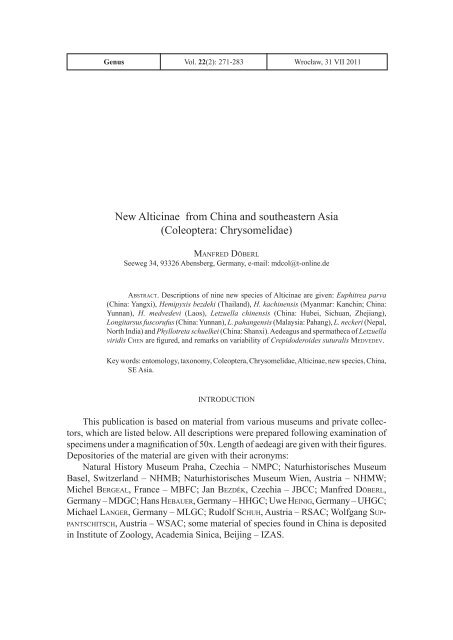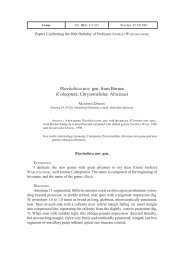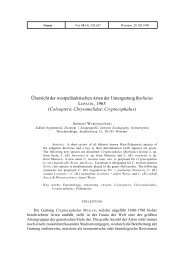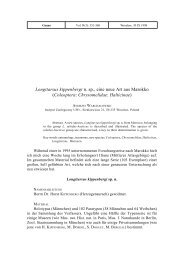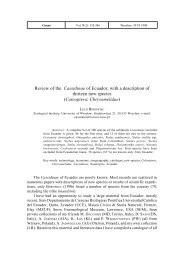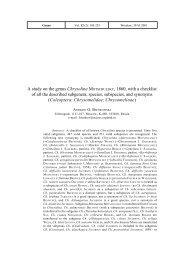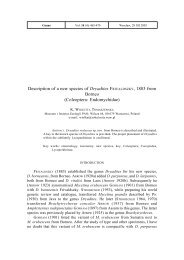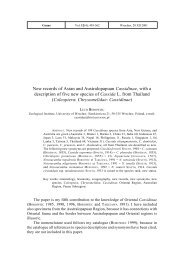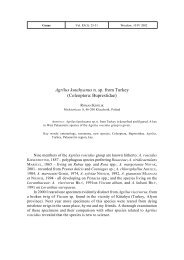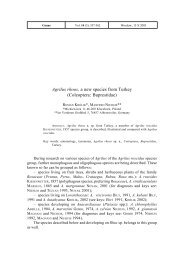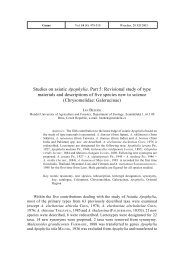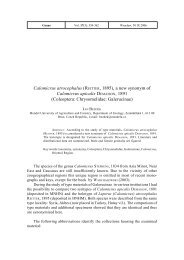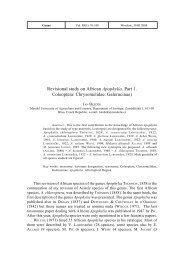New Alticinae from China and southeastern Asia (Coleoptera ...
New Alticinae from China and southeastern Asia (Coleoptera ...
New Alticinae from China and southeastern Asia (Coleoptera ...
You also want an ePaper? Increase the reach of your titles
YUMPU automatically turns print PDFs into web optimized ePapers that Google loves.
Genus Vol. 22(2): 271-283 Wrocław, 31 VII 2011<br />
<strong>New</strong> <strong>Alticinae</strong> <strong>from</strong> <strong>China</strong> <strong>and</strong> <strong>southeastern</strong> <strong>Asia</strong><br />
(<strong>Coleoptera</strong>: Chrysomelidae)<br />
Manfred döberl<br />
Seeweg 34, 93326 Abensberg, Germany, e-mail: mdcol@t-online.de<br />
abstract. Descriptions of nine new species of <strong>Alticinae</strong> are given: Euphitrea parva<br />
(<strong>China</strong>: Yangxi), Hemipyxis bezdeki (Thail<strong>and</strong>), H. kachinensis (Myanmar: Kanchin; <strong>China</strong>:<br />
Yunnan), H. medvedevi (Laos), Letzuella chinensis (<strong>China</strong>: Hubei, Sichuan, Zhejiang),<br />
Longitarsus fuscorufus (<strong>China</strong>: Yunnan), L. pahangensis (Malaysia: Pahang), L. neckeri (Nepal,<br />
North India) <strong>and</strong> Phyllotreta schuelkei (<strong>China</strong>: Shanxi). Aedeagus <strong>and</strong> spermatheca of Letzuella<br />
viridis chen are figured, <strong>and</strong> remarks on variability of Crepidoderoides suturalis Medvedev.<br />
Key words: entomology, taxonomy, <strong>Coleoptera</strong>, Chrysomelidae, <strong>Alticinae</strong>, new species, <strong>China</strong>,<br />
SE <strong>Asia</strong>.<br />
INTroDuCTIoN<br />
This publication is based on material <strong>from</strong> various museums <strong>and</strong> private collectors,<br />
which are listed below. All descriptions were prepared following examination of<br />
specimens under a magnification of 50x. Length of aedeagi are given with their figures.<br />
Depositories of the material are given with their acronyms:<br />
Natural History Museum Praha, Czechia – NMPC; Naturhistorisches Museum<br />
Basel, Switzerl<strong>and</strong> – NHMB; Naturhistorisches Museum Wien, Austria – NHMW;<br />
Michel bergeal, France – MBFC; Jan Bezděk, Czechia – JBCC; Manfred döberl,<br />
Germany – MDGC; Hans hebauer, Germany – HHGC; uwe heinig, Germany – uHGC;<br />
Michael langer, Germany – MLGC; rudolf schuh, Austria – rSAC; Wolfgang suppantschitsch,<br />
Austria – WSAC; some material of species found in <strong>China</strong> is deposited<br />
in Institute of Zoology, Academia Sinica, Beijing – IZAS.
272 MANFrED DöBErL<br />
etyMology<br />
From parvus (lat.) = small.<br />
Euphitrea parva nov. spec.<br />
Figs. 1, 2, 8<br />
Material<br />
Holotype (♂): <strong>China</strong>, Jangxi W, Jinggang Shan, Ciping env., 2. – 14. VI. 1994<br />
(NHMW). Paratypes: 9 Expl. dito (NHMW, MDGC).<br />
diagnosis<br />
A small bicolored Euphitrea species with vertex moderately convex, bordered on<br />
its sides by distinctly incised furrows.<br />
description<br />
(50x): measurements of the holotype (♂): 2.8 x 1.7 mm. Head, pronotum <strong>and</strong><br />
scutellum pitchbrown, elytra black with very weak bluish or greenish lustre; underside,<br />
legs <strong>and</strong> antennal segments 6-11 black; articulations of legs <strong>and</strong> tarsi, <strong>and</strong> top of<br />
last antennal segment reddish-brown; labrum <strong>and</strong> antennal segments 1-4(5) yellow.<br />
In the space between the frontal ridge <strong>and</strong> the eye a setiferous point; antennal calli<br />
elongately trigonate, distinctly raised, small; interantennal space subquadrate, as broad<br />
as a diameter of eyes, the clypeus finely punctate. Labrum with a transverse row of<br />
five setifere points.<br />
Proportions of antennal segments in holotype are as: 19:13:12:13:15:15:16:16<br />
:16:16:23 (1 = 0.01 mm).<br />
Pronotum 1.7 times as broad as long, broadest near the base, disc finely <strong>and</strong> sparsely<br />
punctate, more densely near the base; sides weakly arched, <strong>and</strong> distinctly margined; basal<br />
margin on both sides with a short <strong>and</strong> fine impression. Scutellum rounded trigonate.<br />
Elytra broad oval, humeral calli weak; striae somewhat irregular, partly geminate,<br />
vanishing in the apical third; interstices smooth, with microscopic punctures, the outermost<br />
one completely smooth;<br />
Sexual dimorphism: In ♂♂ first segment of fore <strong>and</strong> mid tarsi but a little dilated,<br />
as broad as the third one, with sides somewhat arched, in ♀♀ narrower than the third<br />
one, with sides straight. Aedeagus as in Figs. 1-2; spermatheca in Fig. 8.<br />
discussion<br />
I put E. parva near E. rufipes chen & Wang, 1980: 7, 20. In contrast to parva, in<br />
rufipes the side borders of vertex are deeply impressed, <strong>and</strong> the legs are yellowish-red;<br />
the aedeagi are similar in both form, but different in length: rufipes L = 0.9 mm, parva<br />
L = 0.7 mm.<br />
distribution<br />
<strong>China</strong>: Jangxi.
NEW ALTICINAE FroM CHINA AND SouTHEASTErN ASIA<br />
Hemipyxis bezdeki nov. spec.<br />
Figs. 3-4<br />
etyMology<br />
Named after the well known Czech entomologist Jan Bezděk.<br />
273<br />
Material<br />
Holotype (♂): Tail<strong>and</strong> NE, prov. Loei, Phu rua N. P., 1000 m, 9.iv.1999, leg. M.<br />
Řiha (JBCC). Paratypes: 2♂♂ dito (JBCC, MDGC); 1 ♂ Thail<strong>and</strong>, prov. Mae Hong<br />
Son, 1400 m, 19°26’N/98°19’E, Kiwlom, near Soppong, 23.vi.- 2.vii.2002, leg. Fouquét<br />
(JBCC); 1 ♂ NW Thail<strong>and</strong>, Chiang Mai, Doi Suthep to Doi Pui, 19.-23. iv. 1991,<br />
leg. J. Horák (MDGC).<br />
diagnosis<br />
A species of the H. chinensis-group; pronotum, anterior <strong>and</strong> mid legs, as well as<br />
anterior part of head yellow-brown, vertex clearly contrasting piceous; elytra metallic<br />
blue.<br />
description<br />
(50x): measurements of the holotype: 3.7 x 2.6 mm. Antennal calli somewhat<br />
rhombic, separated one <strong>from</strong> the other by a finely impressed line; separated <strong>from</strong> vertex<br />
by a shallowly punctate impression; vertex punctate, on both sides with a large isolated<br />
point; frontal ridge very narrow. The distances of the outer resp. inner borders of eyes<br />
are as 2.5 to 1. Proportions of antennal segments in holotype are as 29:16:29:35:35<br />
:35:31:29:30:25:31 (1 = 0.01 mm). Mid segments more than four times longer than<br />
wide. The three basal segments yellow-brown, the following piceous. – Pronotum 2.1<br />
times as broad as long; disk to the anterior corners flattened, broadest at the base, sides<br />
equally arched <strong>and</strong> converging in front, hind corners distinct, anterior corners weakly<br />
dentate outside; disk on a finely wrinkled ground microscopically punctate. Scutellum<br />
elongately-trigonate, black. – Elytra broadly oval, equally <strong>and</strong> confusedly punctate,<br />
the points finely impressed, <strong>and</strong> distant one <strong>from</strong> the other 2.5 times their diameter;<br />
along the outer borders more strongly punctate; humeral calli distinct, separated <strong>from</strong><br />
the disk by a clear depression; near the apex some short <strong>and</strong> very fine scattered hairs.<br />
– Prosternum, <strong>and</strong> anterior legs yellow-brown, hind legs blackish, with tibiae <strong>and</strong> tarsi<br />
lighter; claw-segment of posterior tarsi a little bit arched <strong>and</strong> slightly inflated.<br />
Sexual dimorphism: In ♂♂first segment of fore <strong>and</strong> mid tarsi dilated, as broad as<br />
the third one, with sides somewhat arched; ♀ unknown.<br />
discussion<br />
H. bezdeki st<strong>and</strong>s nearby of H. ioscopa Maulik, 1926, but it is at once to separate<br />
by its bicolored head; see also the aedeagus in Figs. 3-4.<br />
distribution<br />
Thail<strong>and</strong>.
274 MANFrED DöBErL<br />
Hemipyxis kachinensis nov. spec.<br />
Figs. 5-7, 9<br />
etyMology<br />
Named after the locality where holotype was found.<br />
Material<br />
Holotype (♂) Myanmar (Burma), Prov. Kachin State, ca. 20 km N of Panwar,<br />
25° 43’ 302“ N; 98° 23’ 353“ E; 2180 m, Tagfang, 24. v. 2006 leg. Michael Langer,<br />
Stefan Naumann & Swen Löffler (MLGC). Paratypes: 4 ♂♂ 8 ♀♀ dito; 1 ♂ 1 ♀<br />
Myanmar (Burma), Prov. Kachin State, Kanphant, Grenze zu <strong>China</strong>, 26°09’388“ N;<br />
98°30’535“E, 2440 m, Nachtfang, 25. v. 2006 leg. Michael Langer, Stefan Naumann<br />
& Swen Löffler (MLGC, MDGC); 1 ♂ 1 ♀ Myanmar (Burma), Prov. Kachin State,<br />
1-15. Euphitrea parva nov. spec.: 1 – Aed. ventral (apex); 2 – Aed. lateral; L = 0.8 mm; 8 – Spermatheca ;<br />
Hemipyxis bezdeki nov. spec.: 3 – Aed. ventral; Length = 1.6 mm; 4 – Aed. lateral; Hemipyxis kachinensis<br />
nov. spec.: 5 – Aed. ventral; Length = 1.5 mm; 6 – Aed. dorsal; 7 – Aed. lateral; 9 – Sperm.; Letzuella viridis:<br />
10 – Aed. ventral (Apex); 11 – Aed. lateral; Length = 0.75 mm; 12 – Sperm.; Letzuella chinensis nov. spec.:<br />
13 – Sperm.; 14 – Aed. ventral (Apex); 15 – Aed. lateral; L = 0.95 mm; scale = 0.1 mm
NEW ALTICINAE FroM CHINA AND SouTHEASTErN ASIA<br />
275<br />
ca. 20 km N von Panwar, 23. v. 2006, leg. Michael Langer (MDGC); 1 ♂ 3 ♀♀ <strong>China</strong>,<br />
Yunnan prov. 1.3-2.0 km S of Haba, 1.-20. vi. 2007, Haba Xueshan Mts., 2830-3000<br />
m, 27°22.1’N/100°08.2’E; J. Hájek & J. růžička leg. (1 ♂ 2 ♀♀ NMPC; 1 ♀ MDGC);<br />
1♂ <strong>China</strong>, Sichuan (38-40) rd. Danba to Bamei, 35 km W Danba, 255-2750 m, leg.<br />
Puchtner, vi.-vii.2007 (MDGC). remarks: Hájek & růžička collected the species in a<br />
mixed forest (with dominant Pinus) on plants <strong>and</strong> shrubs, but also on fungi.<br />
diagnosis<br />
A species of the H. plagioderes-group. Black, elytra with slight violaceous metallic<br />
sheen; antennae <strong>and</strong> legs dark piceous, three basal segments of antennae but a very<br />
little lighter.<br />
description<br />
(50x): L = 3.8-5.0 mm; Holotype: L = 4.0 mm, B = 2.3 mm). Vertex with distinct<br />
scattered punctures; antennal calli broadly-oval, with a point on the distal end; <strong>from</strong><br />
the vertex separated by a deep transverse impression.<br />
Proportions of antennal segments in holotype are as 38:16:30:37:33:31:34:30<br />
:30:28:40 (1 = 0.01 mm). Pronotum 2.1 times as broad as long; equally transversally<br />
arched, broadest near the base, sides slightly arched, <strong>and</strong> converging to anterior corners;<br />
distinctly margined, anterior corners not toothed; all corners with a small setiferous<br />
point; disk smooth, with microscopic punctures. Scutellum trigonate, smooth.<br />
Elytra longish-oval, broadest somewhat behind the mid; punctation confuse <strong>and</strong><br />
very fine, humeral calli distinct, separated <strong>from</strong> the disk by a clear depression. Hemicyclus<br />
of the last abdominal sternite in ♂♂ with a deep point, followed by a sharply<br />
impressed line up to the hind margin..<br />
Sexual dimorphism: In ♂♂ first segment of fore <strong>and</strong> mid tarsi but a little dilated,<br />
as broad as the third one, with sides somewhat arched, in ♀ but a little narrower than<br />
the third one, with sides straight. ♂♂ (L = 3.8-4.0 mm) distinctly smaller than ♀♀<br />
(4.4-5.0 mm). Aedeagus as in Figs. 5-7; spermatheca in Fig. 9).<br />
diskussion<br />
Hemypixis kachinensis n. sp. st<strong>and</strong>s nearby H. yunnanica (chen, 1933). The ♂♂<br />
of H. kachinensis are as a rule somewhat smaller than those of H. yunnanica (> 4.3<br />
mm). Proper identification is available by comparison of genitalia.<br />
distribution<br />
Myanmar (Kanchin), <strong>China</strong> (Yunnan).<br />
Hemipyxis medvedevi nov. spec.<br />
Figs. 16-17<br />
etyMology<br />
Named after Lev Medvedev, well known entomologist, author of “<strong>Alticinae</strong> of<br />
Indochina”.
276 MANFrED DöBErL<br />
Material<br />
Holotype (♂): Laos, Hua Phan, Ban Salue, Shu Phan Mt. env. 1300-2000 m,<br />
20”13’N/103”59E. 6.-18.v. 2004, leg. J. Bezděk (JBCC). Paratypes: 2 ♂♂ dito (JBCC,<br />
MDGC).<br />
diagnosis<br />
A species of the bipustulata-group; shining black, each elytron with a subtriangular,<br />
pale yellow spot.<br />
description<br />
(50x): measurements of the holotype: 3.9 x 2.5 mm. Head: Vertex smooth, with<br />
scattered very fine punctures; antennal calli subquadrate, shining smooth, delimited<br />
<strong>from</strong> vertex by a straight impression; interantennal space distinctly carinate. Proportions<br />
of antennal segments in holotype are as 31:16:30:33:33:34:33:30:32:30:37 (1 = 0.01<br />
mm). Scutellum trigonate, smooth. – Pronotum subquadrate, two times broader than<br />
long, miscroscopically punctate, evenly vaulted, with sides nearly straight, converging<br />
to the front; anterior angles of pronotum slightly produced outwards, anterior border<br />
deeply concave; side margins distinctly hollowed. – Scutellum trigonate, smooth. Elytra<br />
broadly oval, 1.25 times as long as broad, without basal convexity, humeral calli distinct;<br />
equally <strong>and</strong> finely punctate, the punctures distant one <strong>from</strong> the other about 2.5 times of<br />
their diameter; the spot on each elytra does not reach the suture nor the outer margins.<br />
– Legs <strong>and</strong> underside black. In ♂♂ the basal segment of anterior <strong>and</strong> mid legs is a little<br />
broader than the third one; the claw segments of hind legs are simple.<br />
Sexual dimorphism: Aedeagus (Fig. 16-17) of Hyphasis-habitus; its length: 1.1<br />
mm (without appendix); ♀♀ are unknown.<br />
discussion<br />
Characterized by its uniform shining black colour, <strong>and</strong> the subtriangular spot on<br />
each elytra, which is similar to H. kimotoi döberl, 2007. In the key, given by Medvedev<br />
(2009: 60) this species has its place in thesis 10 as “spec. A”.<br />
distribution<br />
Laos.<br />
etyMology<br />
Named after the type locality.<br />
Letzuella chinensis nov. spec.<br />
Figs. 13-15 (<strong>and</strong> L. viridis: 10-12)<br />
Material<br />
Holotype (♂): <strong>China</strong>, W Hubei, Muyping S. env. 1100m, 31°45’N/110°04’E, 15.-<br />
17. VI. 2002 leg. J. Trna (MDGC). Paratypes: 5♂♂ 6♀♀ dito; 1♂ <strong>China</strong>, W Zhejiang,<br />
Jiulong Shan, 600-700 m, 28°22’N 118°51’E, 14. v. 2008 Jaroslav Turna leg.; 1♀
NEW ALTICINAE FroM CHINA AND SouTHEASTErN ASIA<br />
<strong>China</strong>, Sichuan, Emei-Shan, umg. Din-Shui, ± 1400m, 18. VI. 1996 leg. D. Erber<br />
(HHGC, MDGC, IZAS)<br />
277<br />
diagnosis<br />
An uniformly black Letzuella species with bluish or greenish sheen; fore <strong>and</strong> middle<br />
legs widely yellowish.<br />
description<br />
(50x): Measurements of holotype: L = 3.8 mm, B = 1.8 mm. Head <strong>and</strong> pronotum<br />
black with faint bluish lustre, elytra with distinct bluish or greenish sheen. Head finely<br />
granulated. Antennal calli limited behind by a straight impression; separated by a deep<br />
<strong>and</strong> broad impression; their tops run up to the space between insertions of antennae <strong>and</strong><br />
frontal ridge. Clypeus deeply impressed in front, with a narrow frontal keel, on both<br />
sides deeply hollowed. Proportions of antennal segments in holotype are as 22:16:19:20<br />
:23:21:25:21:21:21:30 (1 = 0.01 mm). Pronotum with surface rugose, densely punctate,<br />
but punctures superficially impressed; 1.66 times as broad as long, broadest near the<br />
base, posterior margin somewhat reflexed, with a weakly transverse impression (best<br />
visible <strong>from</strong> the front). Anterior angles of pronotum distinctly outwards produced <strong>and</strong><br />
thickened; sides narrowly margined; posterior corners widely rounded, only marked by<br />
a small denticle. – Scutellum black, smooth, trigonate with top rounded. Elytra smooth,<br />
densely punctate, with sides subparallel, winged, humeral calli separated <strong>from</strong> the disc<br />
by a distinct impression. underside black, sparsely covered with whitish hairs. Legs<br />
except the black hind femora yellow; also all the trochanters yellow.<br />
Sexual dimorphism: ♂♂ (L = 3.3 x 1.5 mm – 4.0 x 1.9 mm) are a little smaller than<br />
♀♀ (L = 3.6 x 1.7 mm – 4.2 x 2.0 mm). In ♂♂ first segment of anterior tarsi with sides<br />
arched, <strong>and</strong> somewhat inflated, in ♀♀ with sides straight, <strong>and</strong> not inflated. Aedeagus<br />
(Figs. 14-15) in lateral view equally arched, ventrally <strong>from</strong> Apex up to nearly the mid<br />
of length with a shallow impression. Spermatheca as in Fig. 13.<br />
discussion<br />
Presently there are three species of Letzuella known. L. chinensis nov. spec. is characterized<br />
by its completely yellow fore legs <strong>and</strong> its finely granulated head. It is similar<br />
to L. viridis chen, 1933 (figs. 10-12), with the frons smooth, <strong>and</strong> the legs blackish; so<br />
it is in L. himalayensis (Medvedev & sprecher, 1997) too. In L. yonyonae chen, 1933,<br />
the dorsum is dark brown with a cupreous sheen.<br />
distribution<br />
<strong>China</strong> (Hubei, Sichuan, Zhejiang).<br />
Longitarsus fuscorufus nov. spec.<br />
Figs. 25-27<br />
etyMology<br />
Named after its coloration, <strong>from</strong> fuscus (lat.) = brown, rufus (lat.) = red.
278 MANFrED DöBErL<br />
Material<br />
Holotype (♂): <strong>China</strong>, Yunnan, Gaoligonshan Mts., 20. VI. 1993, leg. Sausa<br />
(MDGC); Paratypes: 4 ♂♂, 7 ♀♀ dito (MDGC; 1 ♂ 1 ♀ IZAS).<br />
diagnosis<br />
A medium sized, winged, upside uniformly reddish-brown Longitarsus species;<br />
pronotum subquadratic, antennal calli narrow <strong>and</strong> <strong>from</strong> vertex separated by deeply<br />
engraved furrows.<br />
description<br />
(50x): Measurements of holotype (♂): 2.9 mm x 1.4 mm; ♀♀: 3.3 mm x 1.5 mm.<br />
upside reddish-brown, underside yellowish-brown, head (except the vertex), legs <strong>and</strong><br />
16-30. Hemipyxis medvedevi nov. spec.: 16 – Aed. ventral; Length = 1.05 mm; 17 – Aed. lateral; Phyllotreta<br />
schuelkei nov. spec.: 18 – Flügeldecken; 19 – Aed. ventral; Length = 1.0 mm; 20 – Aed. lateral; 21<br />
– Spermatheca; Longitarsus pahangensis nov. spec.: 22 – Aed. ventral; Length = 1.1 mm; 23 – Aed. lateral;<br />
24 – Sperm.; Longitarsus fuscorufus nov. spec.: 25 – Aed. ventral; Length = 1.15 mm; 26 – Aed. lateral:<br />
27 – Sperm.; Longitarsus neckeri nov. spec.: 28 – Sperm.; 29 – Aed. ventral; Length = 1.15 mm; 30 – Aed.<br />
lateral; scale = 0.1 mm
NEW ALTICINAE FroM CHINA AND SouTHEASTErN ASIA<br />
279<br />
antennae piceous, the latter with segments 1-3 <strong>and</strong> 10-11 reddish-brown, the basal segment<br />
of antennae upside blackish. ocular furrows lacking, frontal lines deeply incised,<br />
forming a sharp angle in the centre; frontal calli long <strong>and</strong> narrow, sharply bordered,<br />
separated one <strong>from</strong> the other by the upper end of frontal ridge. The latter before the<br />
antennal sockets short <strong>and</strong> sharply edged. Antennae reaching the apex of elytra; proportions<br />
of antennal segments in holotype are as 23:12:19:26:28:28:31:34:33:34:48<br />
(1 = 0.01 mm); the second segment but a little more thickened <strong>and</strong> a littler shorter<br />
than the third one. Frons <strong>and</strong> vertex smooth <strong>and</strong> shining, only on both sides with a fine<br />
setiferous pore near the eyes.<br />
Pronotum 1.2 times as broad as long, smooth <strong>and</strong> shining, broadest in anterior part,<br />
somewhat emarginated before the hind corners; anterior corners obliquely truncate,<br />
posterior corners <strong>and</strong> basal margin widely arched, the corners only marked by a sharp<br />
tooth. The disc in posterior half distinctly punctate, but more scattered than elytra.<br />
Scutellum trigonate, smooth <strong>and</strong> shining. Elytra distinctly, densely <strong>and</strong> confusedly<br />
punctate throughout; distance between the points of their own diameter; humeral calli<br />
protruding. Hind tibiae dorsally flattened, without a keel; spur short.<br />
Sexual dimorphism: In ♂♂, sides of the first segment of anterior <strong>and</strong> mid tarsi<br />
curved, <strong>and</strong> as broad as the third one; in ♀♀, sides of first segment of fore <strong>and</strong> mid<br />
tarsi straight, <strong>and</strong> narrower than the third one. Aedeagus <strong>and</strong> spermatheca as in Figs.<br />
25-27).<br />
discussion<br />
I consider L. fuscorufus n. sp. similar to L. zhamicus chen & Wang, 1981: 503,<br />
508, known to me only <strong>from</strong> its description. L. zhamicus is differently punctate on elytra<br />
(“having a certain degree of arrangement in longitudinal striae”), but also differently<br />
coloured (yellow-brown, antennae, front <strong>and</strong> middle legs paler, straw-yellow).<br />
distribution<br />
<strong>China</strong> (Yunnan).<br />
Longitarsus neckeri nov. spec.<br />
Figs. 28-30<br />
etyMology<br />
Named in honour of my deceased friend Georg Necker. He was my dear comrade<br />
in numerous excursions.<br />
Material<br />
Holotype (♂): Nord Indien, uttar Pradesh, Badrinat, 3.200-3.600 m, 1. viii. 1989,<br />
leg. A. riedel (MDGC). Paratypes: 3 ♂♂, 5 ♀♀ dito; 2 ♀♀ Nord Indien, Himachal<br />
Pradesh, Bimla Kufri, 16. vii. 1989, leg. riedel; 1 ♂ Himachal Pradesh, Manali, Solang<br />
Valley, 2.500 m leg. riedel; 9 ♂♂ 1 ♀ Nord Indien, Danolti nr. Mussoorie, 4. ix. 1987,<br />
leg. riedel (MBFC, MDGC, NHMG, uSNM, IZAS).
280 MANFrED DöBErL<br />
diagnosis<br />
A medium sized, winged, <strong>and</strong> black Longitarsus species; antennae reaching the<br />
last third of elytra.<br />
description<br />
(50x): Measurements of holotype: 2.8 mm x 1.4 mm. Black, without any metallic<br />
sheen, segments 1-4 of antennae, as well as base of femora, <strong>and</strong> all tibiae <strong>and</strong> tarsi<br />
lighter. Head smooth <strong>and</strong> shining, microscopically punctate. ocular lines distinctly<br />
impressed, antennal calli rounded, frontal lines shallow. Frontal ridge obtuse. Antennae<br />
about ¾ as long as body. Proportions of antennal segments in holotype are as<br />
25:13:13:20:22:20:22:21:22:22:27 (1 = 0.01 mm); Pronotum shining, 1.3 times wider<br />
than long, with sides uniformly rounded, widest at middle, anterior corners obliquely<br />
truncated, <strong>and</strong> distinctly produced, posterior corners only marked by a small setiferous<br />
pore; disc smooth <strong>and</strong> shining, with scattered very fine punctures, stronger in the basal<br />
region. Scutellum small <strong>and</strong> smooth. Elytra oval, widest at the middle, humeral calli<br />
weak; apices separately rounded; disc confusedly punctate, the punctures feeble <strong>and</strong><br />
small, separated <strong>from</strong> each other 3 times of their diameter; interstices smooth. Hind<br />
tibiae dorsally flattened, without longitudinal ridge; apical spine strong, not as long as<br />
diameter of apex of tibia.<br />
Sexual dimorphism: Measurements of ♂♂: 2.7 x 1.4 mm to 3.0 x 1.5 mm; in ♀♀:<br />
3.1 x 1.5 to 4.3 x 1.6 mm. Basal segment of anterior <strong>and</strong> mid tarsi are twice as long<br />
as wide, not broader than segment three; in ♂♂ but a little swollen. Aedeagus <strong>and</strong><br />
spermatheca as in Figs. 28-30.<br />
discussion<br />
L. neckeri belongs to a group characterized by black colour <strong>and</strong> by a size of 2.8<br />
to 3.6 mm, distinguished <strong>from</strong> other species of the genus which are distinctly smaller.<br />
There are but two species coming in question: L. nepalensis gruev (1988: 101) is very<br />
similar in habitus <strong>and</strong> measurements, <strong>and</strong> in genitalia too, but it is at once to separate<br />
by its yellow pronotum <strong>and</strong> prothorax. – In L. hartmanni Medvedev, 2004: 204 (described<br />
only by ♀) is the pronotum 1.5 times broader than long, the last four segments<br />
of antennae are conspicuously long (four times as long as wide), <strong>and</strong> the ductus of<br />
spermatheca is simple without coils.<br />
distribution<br />
Nepal, North India<br />
Longitarsus pahangensis nov. spec.<br />
Figs. 22-24<br />
etyMology<br />
Named after the region where types were collected, Pahang/Western Malaysia.
NEW ALTICINAE FroM CHINA AND SouTHEASTErN ASIA<br />
281<br />
Material<br />
Holotype (♂): W Malaysia, Pahang, Cameron Highl<strong>and</strong>s, Bringchang, 31. III.<br />
1999, leg. W. Suppantschitsch (MDGC). Paratypes: 1 ♀ dito; 1 ♀ Malaysia, Pahang,<br />
Cameron Highl<strong>and</strong>s, umg. Tanah rata, 1600 m, 27.-31. VII. 1993, leg. r. Schuh<br />
(MDGC, rSAC)<br />
diagnosis<br />
A medium sized, winged, bicolored Longitarsus species with pronotum broadest<br />
anteriorly.<br />
description<br />
(50x): Measurements of holotype (♂): 2.9 mm x 1.3 mm; ♀: 3.1 mm x 1.6 mm.<br />
Black, elytra behind the basal quarter reddish-brown, the colours not sharply separated;<br />
the segments 9-10(11) of antennae, <strong>and</strong> the abdomen, as well as all the fourth segments<br />
of the tarsi yellowish. Vertex shining <strong>and</strong> weakly wrinkled, <strong>from</strong> frons separated by a<br />
shallow depression. The preocular lines are distinct, the antennal calli are fused <strong>and</strong><br />
form shining callosity. Frontal ridge narrow, but obtusely edged. Antennae as long<br />
as the body. Proportions of antennal segments in the holotype are as 25:12:18:26:26<br />
:28:28:28:28:24:31 (1 = 0.01 mm), the second <strong>and</strong> third segments are of nearly identical<br />
thickness. – Pronotum 1.25 times as broad as long, broadest anteriorly, smooth,<br />
anterior corners obliquely truncate, but the pore behind does but scarcely protrude;<br />
posterior corners <strong>and</strong> basal margin widely arched, the corners only marked by a sharp<br />
tooth. Scutellum broadly rounded, smooth. Elytra with humeral calli distinct, finely<br />
<strong>and</strong> shallowly punctate; apex of each elytron individually rounded. Hind tibiae dorsally<br />
flattend, without a keel; spur short.<br />
Sexual dimorphism: In ♂♂ are the basal segments of anterior <strong>and</strong> mid legs very<br />
long <strong>and</strong> their sides are subparallel; they are as broad as the third segment. In ♀♀ the<br />
basal segments are longish-trigonate <strong>and</strong> not as broad as the third one. Aedeagus <strong>and</strong><br />
spermatheca as in Figs. 22-24.<br />
discussion<br />
In the Longitarsus key of Medvedev (2009: 109) L. pahangensi has its place in<br />
thesis 18 beside of L. laosensis Medvedev, 2004, but it can be separated at once by its<br />
unmistakable coloration.<br />
distribution<br />
Malaysia (Pahang).<br />
Phyllotreta schuelkei nov. spec.<br />
Figs. 18-21<br />
etyMologie<br />
Named after the collector Michael schülke, Berlin.
282 MANFrED DöBErL<br />
Material<br />
Holotype (♂): <strong>China</strong>: Shaanxi, Qin Ling Shan, 107.56 E, 33,45 N; Autoroute km<br />
93 S of Zhouzhi, 108 km SW Xian; Mountain Forest, sifted, 1650 m, 1.-2. IX. 1995,<br />
leg. M. Schülke (MDGC). Paratypes: 5 ♀♀ ditto (uHGC, MDGC).<br />
diagnosis<br />
2.4-2.6 mm; a wingless black Phyllotreta species, each elytron with a longitudinal<br />
yellow stripe.<br />
description<br />
(50x): Measurements of holotype (♂): 2.4 mm x 1.2 mm; ♀♀: 2.6 mm x 1.4<br />
mm.<br />
Black, without any metallic lustre, the yellow stripe with its external margin distinctly<br />
sinuate, the black sutural stripe subparallel, but near the basis slightly narrowed<br />
(fig. 18). Legs black with articulations <strong>and</strong> tarsi lightened. Four basal segments of<br />
antennae yellow with the fourth at its end darkened, the following ones black; the last<br />
five segments thickened.<br />
Antennal calli more or less triangular, with their points directed forward between<br />
antennal sockets, separated one <strong>from</strong> the other by a shallow longitudinal impression.<br />
Frons with a broad transverse b<strong>and</strong> of punctures (best visible <strong>from</strong> behind), the punctures<br />
varying in size; vertex smooth. Proportions of antennal segments in holotype<br />
are as 21:11:9:10:12:11:11:13:13:12:14 (1 = 0.01 mm), in ♀ as: 21:12:10:10:13:13<br />
:14:14:13:13:20 (1 = 0.01 mm). – Pronotum 1.45 times broader than long, smooth, with<br />
scattered fine points, side margins near the basis subparallel, then slightly rounded <strong>and</strong><br />
slightly converging. Anterior angles oblique, with a slightly projected pore; posterior<br />
angles rounded. Side borders narrow but sharply margined. Elytra oval, with humeral<br />
calli lacking, uniformly punctate, the points distinctly stronger than those on pronotum.<br />
Scutellum smooth, rounded <strong>and</strong> semicircular.<br />
Sexual dimorphism: In ♂♂ the basal segments of the tarsi of fore- <strong>and</strong> middle<br />
legs are dilated, as broad as the third one; in ♀♀ they are distinctly narrower. Last<br />
abdominal sternite in ♂♂ in the hind portion with a longish round groove. Aedeagus<br />
<strong>and</strong> spermatheca as in Figs. 19-21.<br />
discussion<br />
The new species is most similar to Phyllotreta koltzei Weise. In contrary to the<br />
new species in P. koltzei the vertex is punctate, <strong>and</strong> pronotum <strong>and</strong> elytra are similarly<br />
densely <strong>and</strong> strongly punctate. The black sutural stripe is subparallel up to the basis <strong>and</strong><br />
not narrowed. Fore- <strong>and</strong> middle legs are (except the dark base of femora) uniformly<br />
yellow. In the Phyllotreta-key of gressitt & kiMoto (1963: 873) P. schuelkei has its<br />
place in couplet 6, beside of P.ochripes Curtis <strong>and</strong> P. striolata Illiger. From both species<br />
P. schuelkei can be separated at once by its short segment five of antennae, whereas in<br />
P.ochripes <strong>and</strong> P. striolata segment five of antennae is distinctly longer than four or<br />
six, <strong>and</strong> moreover in the ♂♂ it is conspicuously thickened.
distribution<br />
<strong>China</strong> (Shanxi).<br />
NEW ALTICINAE FroM CHINA AND SouTHEASTErN ASIA<br />
Remarks to Crepidoderoides suturalis Medvedev, 1993:<br />
283<br />
That species was named after its dark suture, but this character is variable. I have<br />
seen specimens of various localities in <strong>China</strong> (Sichuan) with the sutural stripe completely<br />
lacking.<br />
acknowledgeMents<br />
I thank all the museums or colleagues, who trusted me their material for study.<br />
Special thanks go to my dear colleagues Hans hebauer, uwe heinig, <strong>and</strong> Wolfgang<br />
suppantschitsch, who ceded the holotypes of Letzuella chinensis, resp. Longitarsus<br />
pahangensis, resp. Phyllotreta schuelkei in my collection.<br />
rEFErENCES<br />
chen, S. H., 1933: Study of Chinese Halticinae beetles with descriptions of some exotic new species.<br />
Sinensia, 3: 211-254.<br />
chen, S. H., Wang, S., 1980: [<strong>New</strong> genera <strong>and</strong> species of Chinese <strong>Alticinae</strong>]. Entomotaxonomia, 2: 1-24.<br />
(in Chinese with English summary)<br />
—, 1981. <strong>Coleoptera</strong>: Chrysomelidae - <strong>Alticinae</strong>. - Insects of Xizang, 1., p. 491-508.<br />
döberl, M., 2007. Beitrag zur Kenntnis der Gattung Hemipyxis dejean, 1836 – die Arten der indo-malayischen<br />
region mit Einschluß der ostpaläarktischen Arten (<strong>Coleoptera</strong>: Chrysomelidae: <strong>Alticinae</strong>) 1. Teil.<br />
russian Entomol. Journ., 16: 79-99.<br />
gressitt, J. L., kiMoto, S., 1963. The Chrysomelidae (Coleopt.) of <strong>China</strong> <strong>and</strong> Korea, part 2. Pacific Insects<br />
Monograph, 1B: 301-1026.<br />
gruev, B., 1988. A <strong>New</strong> Species of Longitarsus latreille <strong>from</strong> Nepal (<strong>Coleoptera</strong>, Chrysomelidae: <strong>Alticinae</strong>).<br />
Entomol. rev. Japan, 43: 101-102.<br />
Medvedev, L. N., 1993. <strong>New</strong> species of Chrysomelidae <strong>from</strong> South <strong>Asia</strong> <strong>from</strong> the Natural History Museum<br />
in Basel. Entomol. Basiliensia, 16: 359-376.<br />
—, 2004. <strong>New</strong> species of Chrysomelidae (<strong>Coleoptera</strong>) <strong>from</strong> Nepal, Veröff. Naturkundemus. Erfurt, 23:<br />
203-206<br />
—, 2009. <strong>Alticinae</strong> of Indochina. Moskau 2009, 223 pp.<br />
Medvedev, L. N., sprecher-uebersax, E., 1997. Chrysomelidae of Nepal <strong>and</strong> neighbouring regions.<br />
(<strong>Coleoptera</strong> Basiliensia: Chrysomelidae). <strong>Coleoptera</strong>. Schwanfelder Coleopterol, Mitt., 1:<br />
203-248.


